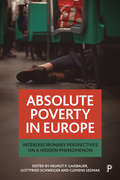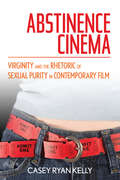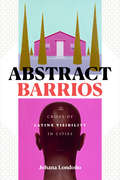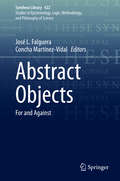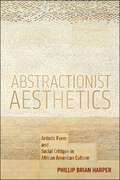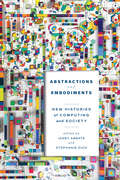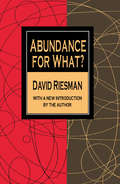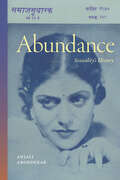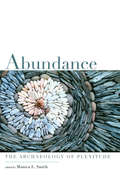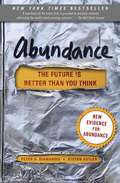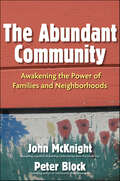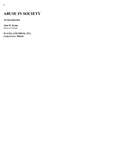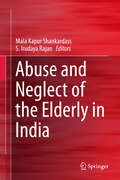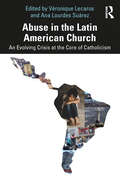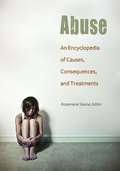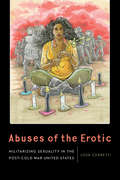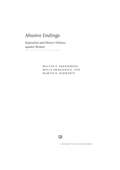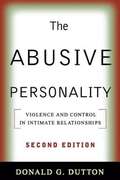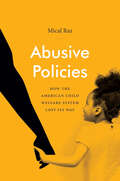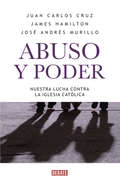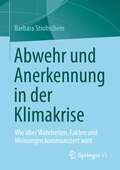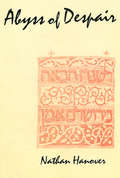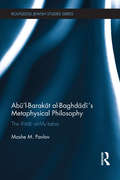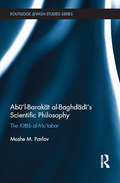- Table View
- List View
Absolute Poverty in Europe: Interdisciplinary Perspectives on a Hidden Phenomenon
by Helmut P. Gaisbauer, Gottfried Schweiger and Clemens SedmakEngaging systematically with severe forms of poverty in Europe, this important book stimulates academic, public and policy debate by shedding light on aspects of deprivation and exclusion of people in absolute poverty in affluent societies. It examines issues such as access to health care, housing and nutrition, poverty related shame, and violence. The book investigates different policy and civic responses to extreme poverty, ranging from food donations to penalisation and “social cleansing” of highly visible poor and how it is related to concerns of ethics, justice and human dignity.
Abstinence Cinema: Virginity and the Rhetoric of Sexual Purity in Contemporary Film
by Casey Ryan KellyFrom the perspective of cultural conservatives, Hollywood movies are cesspools of vice, exposing impressionable viewers to pernicious sexually-permissive messages. Offering a groundbreaking study of Hollywood films produced since 2000, Abstinence Cinema comes to a very different conclusion, finding echoes of the evangelical movement's abstinence-only rhetoric in everything from Easy A to Taken. Casey Ryan Kelly tracks the surprising sex-negative turn that Hollywood films have taken, associating premarital sex with shame and degradation, while romanticizing traditional nuclear families, courtship rituals, and gender roles. As he demonstrates, these movies are particularly disempowering for young women, concocting plots in which the decision to refrain from sex until marriage is the young woman's primary source of agency and arbiter of moral worth. Locating these regressive sexual politics not only in expected sites, like the Twilight films, but surprising ones, like the raunchy comedies of Judd Apatow, Kelly makes a compelling case that Hollywood films have taken a significant step backward in recent years. Abstinence Cinema offers close readings of movies from a wide spectrum of genres, and it puts these films into conversation with rhetoric that has emerged in other arenas of American culture. Challenging assumptions that we are living in a more liberated era, the book sounds a warning bell about the powerful cultural forces that seek to demonize sexuality and curtail female sexual agency.
Abstract Barrios: The Crises of Latinx Visibility in Cities
by Johana LondoñoIn Abstract Barrios Johana Londoño examines how Latinized urban landscapes are made palatable for white Americans. Such Latinized urban landscapes, she observes, especially appear when whites feel threatened by concentrations of Latinx populations, commonly known as barrios. Drawing on archival research, interviews, and visual analysis of barrio built environments, Londoño shows how over the past seventy years urban planners, architects, designers, policy makers, business owners, and other brokers took abstracted elements from barrio design—such as spatial layouts or bright colors—to safely “Latinize” cities and manage a long-standing urban crisis of Latinx belonging. The built environments that resulted ranged from idealized notions of authentic Puerto Rican culture in the interior design of New York City’s public housing in the 1950s, which sought to diminish concerns over Puerto Rican settlement, to the Fiesta Marketplace in downtown Santa Ana, California, built to counteract white flight in the 1980s. Ultimately, Londoño demonstrates that abstracted barrio culture and aesthetics sustain the economic and cultural viability of normalized, white, and middle-class urban spaces.
Abstract Objects: For and Against (Synthese Library #422)
by José L. Falguera Concha Martínez-VidalThis volume examines the question “Do abstract objects exist?”, presenting new work from contributing authors across different branches of philosophy. The introduction overviews philosophical debate which considers: what objects qualify as abstract, what do we mean by the word "exist” and indeed, what evidence should count in favor or against the thesis that abstract objects exist. Through subsequent chapters readers will discover the ubiquity of abstract objects as each philosophical field is considered.Given the ubiquitous use of expressions that purportedly refer to abstract objects, we think that it is relevant to attend to the controversy between those who want to advocate the existence of abstract objects and those who stand against them. Contributions to this volume depict positions and debates that directly or indirectly involve taking one position or other about abstract objects of different kinds and categories. The volume provides a variety of samples of how positions for or against abstract objects can be used in different areas of philosophy in relation to different matters.
Abstractionist Aesthetics: Artistic Form and Social Critique in African American Culture (NYU Series in Social and Cultural Analysis #5)
by Phillip Brian HarperAn artistic discussion on the critical potential of African American expressive cultureIn a major reassessment of African American culture, Phillip Brian Harper intervenes in the ongoing debate about the “proper” depiction of black people. He advocates for African American aesthetic abstractionism—a representational mode whereby an artwork, rather than striving for realist verisimilitude, vigorously asserts its essentially artificial character. Maintaining that realist representation reaffirms the very social facts that it might have been understood to challenge, Harper contends that abstractionism shows up the actual constructedness of those facts, thereby subjecting them to critical scrutiny and making them amenable to transformation.Arguing against the need for “positive” representations, Abstractionist Aesthetics displaces realism as the primary mode of African American representational aesthetics, re-centers literature as a principal site of African American cultural politics, and elevates experimental prose within the domain of African American literature. Drawing on examples across a variety of artistic production, including the visual work of Fred Wilson and Kara Walker, the music of Billie Holiday and Cecil Taylor, and the prose and verse writings of Ntozake Shange, Alice Walker, and John Keene, this book poses urgent questions about how racial blackness is made to assume certain social meanings. In the process, African American aesthetics are upended, rendering abstractionism as the most powerful modality for Black representation.
Abstractions and Embodiments: New Histories of Computing and Society (Studies in Computing and Culture)
by Janet Abbate and Stephanie DickCutting-edge historians explore ideas, communities, and technologies around modern computing to explore how computers mediate social relations.Computers have been framed both as a mirror for the human mind and as an irreducible other that humanness is defined against, depending on different historical definitions of "humanness." They can serve both liberation and control because some people's freedom has historically been predicated on controlling others. Historians of computing return again and again to these contradictions, as they often reveal deeper structures.Using twin frameworks of abstraction and embodiment, a reformulation of the old mind-body dichotomy, this anthology examines how social relations are enacted in and through computing. The authors examining "Abstraction" revisit central concepts in computing, including "algorithm," "program," "clone," and "risk." In doing so, they demonstrate how the meanings of these terms reflect power relations and social identities. The section on "Embodiments" focuses on sensory aspects of using computers as well as the ways in which gender, race, and other identities have shaped the opportunities and embodied experiences of computer workers and users. Offering a rich and diverse set of studies in new areas, the book explores such disparate themes as disability, the influence of the punk movement, working mothers as technical innovators, and gaming behind the Iron Curtain. Abstractions and Embodiments reimagines computing history by questioning canonical interpretations, foregrounding new actors and contexts, and highlighting neglected aspects of computing as an embodied experience. It makes the profound case that both technology and the body are culturally shaped and that there can be no clear distinction between social, intellectual, and technical aspects of computing. Contributors: Janet Abbate, Marc Aidinoff, Troy Kaighin Astarte, Ekaterina Babinsteva, André Brock, Maarten Bullynck, Jiahui Chan, Gerardo Con Diaz, Liesbeth De Mol, Stephanie Dick, Kelcey Gibbons, Elyse Graham, Michael J. Halvorson, Mar Hicks, Scott Kushner, Xiaochang Li, Zachary Loeb, Lisa Nakamura, Tiffany Nichols, Laine Nooney, Elizabeth Petrick, Cierra Robson, Hallam Stevens, Jaroslav Švelch
Abu Nidal: A Gun for Hire
by Patrick SealeBritish journalist Seale, distinguished as a Middle East specialist, details the Arab terrorist's career, the sources of his vast personal fortune, the motives behind his acts of terrorism and his ties to various Middle East and European governments.
Abundance for What?
by David RiesmanThis classic collection of essays by David Riesman discusses the implications of affluence in America. Riesman maintains that the question that should be raised by wealth has shifted over time from how to obtain wealth to how to make use of it. Another key theme concerns issues relevant to higher education, such as academic freedom. Abundance for What? examines the notion that America is not as open a society as it may appear to be; it then shows how social science may be used to explain why this is so. And now in a brilliant, lengthy reevaluation Riesman both clarifies and revises that earlier assessment with unusual luster and candor., The volume begins with a group of essays that describe the impact of the Cold War. After warning against depending on a war economy, Riesman shifts the focus of discussion to a central characteristic of the Cold War epoch: the uses and abuses of abundance in expanding leisure time. Several essays deal with suburbs as the locale of abundance, while others study the place of the automobile in American life. Riesman describes the impact of American abundance on other nations. Among the many other subjects discussed in Abundance for What? are the education of women, generational shifts in attitudes, and a study of the national character., In his major new 100-page introduction, Riesman also relates the experiences that originally inspired him to write these essays. He then talks about the social and historical changes that have occurred since their publication. His synthesis of old Ideas with contemporary ones makes this a compelling volume. Abundance for What? continues to hold a significant place in the social and cultural critiques of contemporary America and will be of interest to historians, psychologists, educators, and urban policymakers alike.
Abundance: Sexuality’s History (Theory Q)
by Anjali ArondekarIn Abundance, Anjali Arondekar refuses the historical common sense that archival loss is foundational to a subaltern history of sexuality, and that the deficit of our minoritized pasts can be redeemed through acquisitions of lost pasts. Instead, Arondekar theorizes the radical abundance of sexuality through the archives of the Gomantak Maratha Samaj—a caste-oppressed devadasi collective in South Asia—that are plentiful and quotidian, imaginative and ordinary. For Arondekar, abundance is inextricably linked to the histories of subordinated groups in ways that challenge narratives of their constant devaluation. Summoning abundance over loss upends settled genealogies of historical recuperation and representation and works against the imperative to fix sexuality within wider structures of vulnerability, damage, and precarity. Multigeneric and multilingual, transregional and historically supple, Abundance centers sexuality within area, post/colonial, and anti/caste histories.
Abundance: The Archaeology of Plenitude
by Monica L. SmithUsing case studies from around the globe—including Mesoamerica, North and South America, Africa, China, and the Greco-Roman world—and across multiple time periods, the authors in this volume make the case that abundance provides an essential explanatory perspective on ancient peoples’ choices and activities. Economists frequently focus on scarcity as a driving principle in the development of social and economic hierarchies, yet focusing on plenitude enables the understanding of a range of cohesive behaviors that were equally important for the development of social complexity. Our earliest human ancestors were highly mobile hunter-gatherers who sought out places that provided ample food, water, and raw materials. Over time, humans accumulated and displayed an increasing quantity and variety of goods. In households, shrines, tombs, caches, and dumps, archaeologists have discovered large masses of materials that were deliberately gathered, curated, distributed, and discarded by ancient peoples. The volume’s authors draw upon new economic theories to consider the social, ideological, and political implications of human engagement with abundant quantities of resources and physical objects and consider how individual and household engagements with material culture were conditioned by the quest for abundance. Abundance shows that the human propensity for mass consumption is not just the result of modern production capacities but fulfills a longstanding focus on plenitude as both the assurance of well-being and a buffer against uncertainty. This book will be of great interest to scholars and students in economics, anthropology, and cultural studies. Contributors: Traci Ardren, Amy Bogaard, Elizabeth Klarich, Abigail Levine, Christopher R. Moore, Tito E. Naranjo, Stacey Pierson, James M. Potter, François G. Richard, Christopher W. Schmidt, Carol Schultze, Payson Sheets, Monica L. Smith, Katheryn C. Twiss, Mark D. Varien, Justin St. P. Walsh, María Nieves Zedeño
Abundance: The Future Is Better Than You Think (Exponential Technology Series)
by Steven Kotler Peter H. DiamandisThe New York Times bestselling &“manifesto for the future that is grounded in practical solutions addressing the world&’s most pressing concerns: overpopulation, food, water, energy, education, health care and freedom&” (The Wall Street Journal).Since the dawn of humanity, a privileged few have lived in stark contrast to the hardscrabble majority. Conventional wisdom says this gap cannot be closed. But it is closing—and fast. In Abundance, space entrepreneur turned innovation pioneer Peter H. Diamandis and award-winning science writer Steven Kotler document how progress in artificial intelligence, robotics, digital manufacturing synthetic biology, and other exponentially growing technologies will enable us to make greater gains in the next two decades than we have in the previous 200 years. We will soon have the ability to meet and exceed the basic needs of every person on the planet. Abundance for all is within our grasp. Breaking down human needs by category—water, food, energy, healthcare, education, freedom—Diamandis and Kotler introduce us to innovators and industry captains making tremendous strides in each area. &“Not only is Abundance a riveting page-turner…but it&’s a book that gives us a future worth fighting for&” (The Christian Science Monitor).
Abundant Community: Awakening the Power of Families and Neighborhoods
by John McKnightWe need our neighbors and community to stay healthy, produce jobs, raise our children, and care for those on the margin. Institutions and professional services have reached their limit of their ability to help us. The consumer society tells us that we are insufficient and that we must purchase what we need from specialists and systems outside the community. We have become consumers and clients, not citizens and neighbors. John McKnight and Peter Block show that we have the capacity to find real and sustainable satisfaction right in our neighborhood and community. This book reports on voluntary, self-organizing structures that focus on gifts and value hospitality, the welcoming of strangers. It shows how to reweave our social fabric, especially in our neighborhoods. In this way we collectively have enough to create a future that works for all.
Abuse In Society: An Introduction
by Alan R. KempToday's headlines are filled with increasingly alarming accounts of abuse by coaches, religious leaders, institutional caregivers, family members, and others. Abuse in Society provides an illuminating and timely introduction to the physical, emotional/psychological, and sexual faces of abuse. The text presents a much-needed, in-depth assessment of child maltreatment, intimate partner violence, abuse by clergy, abuse of the elderly and disabled, and abuse in sports. Among the specific problems covered are bullying and sibling abuse, courtship violence and date rape, and abuse in the relationships of sexual minorities. The author explores these complex issues using an ecological approach, examining interacting explanations from a variety of perspectives and levels of analysis: societal and cultural, family, and individual.
Abuse and Neglect of the Elderly in India
by S. Irudaya Rajan Mala Kapur ShankardassThis book highlights different aspects of the problem of elder abuse and neglect in India, and discusses its forms as well as means of prevention, intervention and management. It presents a framework for understanding the occurrence of elder abuse and neglect in India, placing the discussion within the global context. Elder abuse and neglect is a growing concern in South Asia, and this is the first comprehensive account of the topic from India. It uses data from different parts of India to describe the various dimensions of elder abuse and neglect among different population categories and sections in society. Covering rural and urban areas in different states, it discusses current perspectives on elder abuse and neglect at the household level, widows, HIV-affected populations, and those residing in institutions. This book comprises views from experts in the field and is of interest to researchers and academics from the social and behavioural sciences, policy makers, and NGOs.
Abuse in the Latin American Church: An Evolving Crisis at the Core of Catholicism
by Véronique Lecaros Ana Lourdes SuárezThis book addresses the crisis of sexual abuse in the Roman Catholic Church in Latin America, the region of the world with the highest percentage of Catholics. Bringing together research from across the continent, it demonstrates that abuse within the Church is indeed a global phenomenon, though abuses have taken different forms according to varying sociocultural contexts. With attention to abuses committed against children, women and vulnerable adults – by both men and women – within the settings of parishes, new religious movements and international religious organizations, it also raises questions of justice, asking how to assess the suffering of victims, how to deal with abusers and how to prevent abuses. It will therefore be of interest to scholars of religious studies, sociology, Latin American studies, criminology, theology, and religious leaders with interests in the abuses and scandals that have been revealed in the worldwide Church.
Abuse: An Encyclopedia Of Causes, Consequences, And Treatments
by Rosemarie SkaineAbuse, a key theme of health education curricula, is also a major issue faced by many segments of society. Intended for high school students as well as undergraduates and the general reader, this comprehensive encyclopedia explores abuse in all its forms--physical, sexual, emotional, and verbal--among a variety of age and demographic groups from children to the elderly to the disabled. It sheds light on causes and symptoms of abuse, examines lasting impacts, and suggests avenues for prevention and treatment. <P><P> Specific topics of concern to a secondary school audience include bullying and cyberbullying; abuse of those in same-sex relationships; and sexual abuse through rape, date rape, incest, and sexting. Elder abuse, which has become of greater concern as our society ages, is covered, as are domestic abuse, child abuse, and abduction. Through up-to-date entries by expert contributors, readers will learn about the causes and results of specific types of abuse, as well as their legal and sociological dimensions. The title will also serve as a gateway to further study--and as a resource for readers seeking help.
Abuses of the Erotic: Militarizing Sexuality in the Post-Cold War United States (Expanding Frontiers: Interdisciplinary Approaches to Studies of Women, Gender, and Sexuality)
by Josh CerrettiEvents ranging from sexual abuse at Abu Ghraib to the end of “Don’t Ask, Don’t Tell” hint that important issues surrounding gender and sexuality remain at the core of political and cultural problems. Nonetheless, intersectional analyses of militarism that account for questions of race, class, and gender remain exceedingly rare. Abuses of the Erotic fills this gap by offering a comprehensive picture of how military values have permeated the civilian cultural sphere and by investigating connections between sexuality and militarism in the United States since the late 1980s. Josh Cerretti takes up the urgent task of applying an interdisciplinary, transnational framework to the role of sexuality in promoting, expanding, and sustaining the war on terror to understand the links between what Cerretti calls “domestic militarism” and later projects of state-backed violence and intervention. This work brings together scholarship on domestic and international militarization in relation to both homosexuality and heterosexuality to demonstrate how sexual and gender politics have been deployed to bolster U.S. military policies and, by tracking over a decade of militarized sexuality, how these instances have foundationally changed how we think of sexual and gender politics today.
Abusive Endings: Separation and Divorce Violence against Women
by Martin D. Schwartz Walter S. Dekeseredy Molly DragiewiczAbusive Endings offers a thorough analysis of the social-science literature on one of the most significant threats to the health and well-being of women today—abuse at the hands of their male partners. The authors provide a moving description of why and how men abuse women in myriad ways during and after a separation or divorce. The material is punctuated with the stories and voices of both perpetrators and survivors of abuse, as told to the authors over many years of fieldwork. Written in a highly readable fashion, this book will be a useful resource for researchers, practitioners, activists, and policy makers.
Abusive Personality, Second Edition
by K. O'Leary Donald DuttonThis influential book provides an innovative framework for understanding and treating intimate partner violence. Integrating a variety of theoretical and empirical perspectives, Donald G. Dutton demonstrates that male abusiveness is more than just a learned pattern of behavior--it is the outgrowth of a particular personality configuration. He illuminates the development of the abusive personality from early childhood to adulthood and presents an evidence-based treatment approach designed to meet this population's unique needs. The second edition features two new chapters on the neurobiological roots of abusive behavior and the development of abusiveness in females.
Abusive Policies: How the American Child Welfare System Lost Its Way (Studies in Social Medicine)
by Mical RazIn the early 1970s, a new wave of public service announcements urged parents to "help end an American tradition" of child abuse. The message, relayed repeatedly over television and radio, urged abusive parents to seek help. Support groups for parents, including Parents Anonymous, proliferated across the country to deal with the seemingly burgeoning crisis. At the same time, an ever-increasing number of abused children were reported to child welfare agencies, due in part to an expansion of mandatory reporting laws and the creation of reporting hotlines across the nation. Here, Mical Raz examines this history of child abuse policy and charts how it changed since the late 1960s, specifically taking into account the frequency with which agencies removed African American children from their homes and placed them in foster care. Highlighting the rise of Parents Anonymous and connecting their activism to the sexual abuse moral panic that swept the country in the 1980s, Raz argues that these panics and policies—as well as biased viewpoints regarding race, class, and gender—played a powerful role shaping perceptions of child abuse. These perceptions were often directly at odds with the available data and disproportionately targeted poor African American families above others.
Abuso y poder: Nuestra lucha contra la Iglesia Católica
by James Hamilton Juan Carlos Cruz JOSE MURILLOLa historia de un largo proceso de búsqueda de justicia por parte de tres víctimas del caso Karadima Desde que el Caso Karadima se transformara en uno de los más significativos casos de abuso en la iglesia chilena, el camino que han seguido tres de sus víctimas ha estado rodeado de dificultades. Sin embargo, desde que el papa Francisco los recibiera en el Vaticano, ocho años después, esa historia (y la historia de la iglesia chilena) ha tenido un giro orientado a la búsqueda de reparación por los daños causados. Esta es su historia.
Abwehr und Anerkennung in der Klimakrise: Wie über Wahrheiten, Fakten und Meinungen kommuniziert wird
by Barbara StrohscheinAuf Wahrheiten, Fakten und Meinungen zur Klimafrage wird häufig öffentlich wie privat mit psychischer oder sozialer Abwehr reagiert. Gestützt auf ausgewählte psychologische und philosophische Theorien sowie Datenmaterial wird in diesem Buch gezeigt, wie Abwehr zustande kommt, wie sie wirkt und wie andererseits die notwendige Anerkennung auf verschiedenen Ebenen gelingen kann. Erst durch Anerkennung werden konstruktive Diskurse möglich. Dieses Buch bietet alle Grundlagen, um Kommunikationskonflikte zwischen Abwehr und Anerkennung in der Klimakrise theoretisch und praktisch lösen zu können.
Abyss of Despair
by Nathan HanoverProviding a gripping, first-hand account of the Chmielnicki massacres in 1648-58, in which tens of thousands of Jews perished in Poland and the Ukraine, Rabbi Nathan Hanover describes the events themselves and their effect on European Jewry. Hanover's description of the atrocities commited* by Chmielnicki and his hordes makes it clear that they set the precedent for Hitler's torture chambers. Hanover's account of the events understood in their historical context 'shows how humans can transcend tragedy and rebuild their lives, developing new ways to express their heritage and culture. Professor Helmreich, in his new introduction, describes the- period of relative peace and prosperity for the Jews immediately preceding the massacres. He traces some of the important effects the massacre had on later Jewish history, such as the rise of Messianic and Hasidic movements in the seventeenth and eighteenth centuries and the migration of Jews back toward the west, where they were situated when the Enlightenment swept through Europe.
Abū’l-Barakāt al-Baghdādī’s Metaphysical Philosophy: The Kitāb al-Mu‘tabar (Routledge Jewish Studies Series)
by Moshe M PavlovAbū’l-Barakāt is a renowned philosopher of the Arabic-Jewish milieu who composed in his magnum opus the Kitāb al-Mu‘tabar, a comprehensive metaphysics which challenged the accepted notions of the traditional metaphysical philosophy. ‘Abū’l-Barakāt al-Baghdādī’s Metaphysical Philosophy’ examines the novel philosophical conceptions of the first book of the Metaphysics of the Kitāb al-Mu‘tabar. The aim is to present a developed conception of Abū’l-Barakāt’s systematic metaphysics. This is accomplished by following the order of topics discussed, while translating the relevant passages. These different topics comprise stages of cognition that move from an analysis of time, creation and causality to the conception of a higher spiritual realm of mental entities and a conception of God as the First Knower and Teacher. The epistemological and ontological conceptions are analyzed at each culminating stage. ‘Abū’l-Barakāt al-Baghdādī’s Metaphysical Philosophy’ analyzes vast portions of the metaphysical study for the first time. The book will thus be a valuable resource for all those seeking an original and broad metaphysics, and for students and scholars of Jewish and Islamic Philosophy. Furthermore, it is of importance for those seeking a metaphysics related to scientific theories and those interested in the history of science and metaphysics.
Abū’l-Barakāt al-Baghdādī’s Scientific Philosophy: The Kitāb al-Mu‘tabar (Routledge Jewish Studies Series)
by Moshe M. PavlovAbū’l-Barakāt is often considered one of the most comprehensive philosophers of the Arabic-Jewish milieu in the medieval age. His extensive and unique philosophical theories, especially his theories in the particular sciences, were seen as a major challenge for the traditional conceptions of the Aristotelian school of thought during and after this period. ‘Abū’l-Barakāt al-Baghdādī’s Scientific Philosophy’ explores the core material of Abū’l-Barakāt’s scientific studies, found in his magnum opus the Kitāb al-Mu‘tabar. The book then locates these scientific theories within Abū’l-Barakāt’s philosophy more widely. Whilst providing a comprehensive critique of ancient philosophy, including the work of Aristotle, certain affinities between Abū’l-Barakāt’s work and that of more modern scientific conceptions are also examined. Containing vast amounts of previously untranslated text, ‘Abū’l-Barakāt al-Baghdādī’s Scientific Philosophy’ sheds new light on the philosopher’s scientific theories, particularly with regards to his logical conceptions. For this reason, the book will be a valuable resource for students and scholars of Jewish and Islamic Philosophy, whilst the scientific material will appeal to those studying the history of science.
